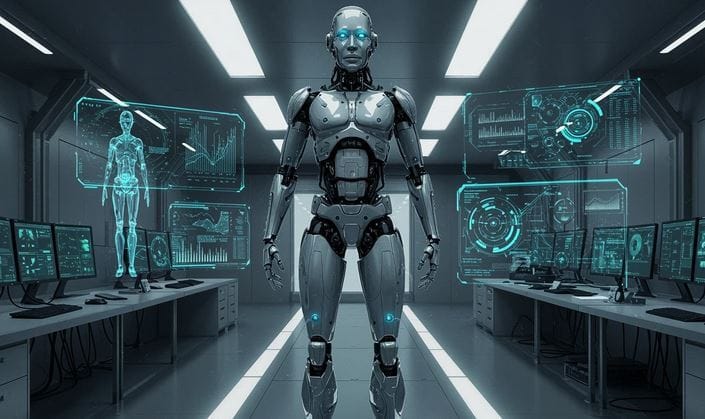- The CyberLens Newsletter
- Posts
- AI Enhanced Vulnerability Scanners with Post Quantum Detection Capabilities
AI Enhanced Vulnerability Scanners with Post Quantum Detection Capabilities
The next frontier in cyber defense technology and its double-edged potential

How can AI power your income?
Ready to transform artificial intelligence from a buzzword into your personal revenue generator
HubSpot’s groundbreaking guide "200+ AI-Powered Income Ideas" is your gateway to financial innovation in the digital age.
Inside you'll discover:
A curated collection of 200+ profitable opportunities spanning content creation, e-commerce, gaming, and emerging digital markets—each vetted for real-world potential
Step-by-step implementation guides designed for beginners, making AI accessible regardless of your technical background
Cutting-edge strategies aligned with current market trends, ensuring your ventures stay ahead of the curve
Download your guide today and unlock a future where artificial intelligence powers your success. Your next income stream is waiting.

Interesting Tech Fact:
In the early 1980s, before flatbed scanners became common in offices, a rare experimental device called the Scan-o-Tron was developed by a small engineering team in Sweden to digitize blueprints for shipbuilding. Unlike modern optical scanners, it used a mechanical arm with precision light sensors that physically traced each line of a document, translating it into early CAD-compatible data. The process was slow—taking up to an hour for a single page—but it marked one of the first known instances of a scanner being purpose-built for engineering data transfer, decades before digital blueprint sharing became standard. This little-known innovation quietly bridged the gap between analog drafting and the digital design revolution.
Introduction
The cybersecurity industry is standing at a pivotal crossroads. On one side, adversaries are arming themselves with increasingly sophisticated AI-driven attack tools. On the other, defenders are adopting equally advanced methods—among them, AI enhanced vulnerability scanners capable of detecting weaknesses far beyond the reach of traditional tools. Now, the newest evolution in this space merges AI scanning with post-quantum detection capabilities—a leap that could redefine how organizations safeguard their digital infrastructures in the coming era of quantum computing. Yet, like any transformative technology, the promise comes with complexity, risk, and the need for strict governance.
These scanners are more than just upgraded versions of standard vulnerability assessment tools. By fusing machine learning’s pattern-recognition strengths with predictive analytics, they can identify zero-day weaknesses and configuration flaws with unprecedented accuracy. But the real game-changer lies in their post-quantum readiness. Quantum computers—once mature—could break widely used encryption in minutes. This reality has pushed defenders to integrate quantum-resistant algorithms and quantum-threat simulation models into AI scanners, enabling them to identify not only today’s vulnerabilities but also those that could be exploited in a post-quantum world. This is no longer hypothetical—it’s proactive cyber defense on a timeline that anticipates the future instead of reacting to it.

The Core of AI Enhanced Vulnerability Scanning
Automated Intelligence – AI replaces static scanning with adaptive learning, evolving with every scan cycle to recognize new attack vectors.
Contextual Awareness – Scanners can assess vulnerabilities in the context of business-critical assets, prioritizing threats based on impact, not just severity.
Threat Prediction – Machine learning models detect emerging patterns that may signal unknown exploits before they are documented publicly.
Post-Quantum Simulation – Systems run quantum threat emulation to test encryption resilience against hypothetical quantum attacks.
Why Post-Quantum Detection Matters
Post-quantum detection capabilities are the response to a looming problem: the inevitable arrival of quantum cryptanalysis. Today’s encryption schemes—RSA, ECC, and many TLS configurations—are built on mathematical problems that quantum algorithms like Shor’s can solve exponentially faster than classical computers. The threat isn’t here yet at full scale, but “harvest now, decrypt later” attacks are already happening, where adversaries collect encrypted data now to decrypt in the quantum future.
An AI enhanced vulnerability scanner equipped with post-quantum detection does more than identify current encryption weaknesses. It evaluates whether existing security controls will withstand quantum-enabled attacks, flags assets with outdated cryptographic standards, and suggests migration paths to post-quantum cryptography (PQC) algorithms recommended by bodies like NIST. In highly regulated industries—finance, healthcare, defense—this forward-looking capability can mean the difference between resilience and catastrophic compromise.
Moreover, these scanners can integrate threat intelligence feeds on quantum research breakthroughs, adjusting scanning priorities in real time. This dynamic, context-aware approach ensures that defenses evolve not annually, but daily, matching the pace of both AI-enhanced and quantum-augmented threats.
The Post-Quantum Detection Workflow
Data Mapping – Catalog all encrypted assets, including data in transit, at rest, and in use.
Algorithm Fingerprinting – Identify which cryptographic algorithms and key lengths are in use.
Quantum Threat Simulation – Model the likelihood of quantum-assisted decryption success based on current research timelines.
Risk Scoring – Assign post-quantum vulnerability ratings to assets, factoring both current and future threats.
Mitigation Guidance – Recommend PQC migration strategies, hybrid encryption models, and layered security controls.
The Negative Aspects and Potential for Abuse
Despite their defensive promise, AI enhanced vulnerability scanners with post-quantum capabilities carry notable risks. First, overreach and misuse: if deployed without strict access controls, such scanners could be turned into highly effective offensive tools, mapping vulnerabilities at a scale and precision that rivals nation-state cyber units. A compromised scanner—especially one integrated into enterprise networks—could hand attackers a detailed blueprint of every exploitable weakness, including those only visible through post-quantum simulations.
Second, false positives and decision fatigue remain significant challenges. AI, while powerful, can misinterpret anomalies as threats, potentially leading to costly and unnecessary overhauls. Conversely, a poorly trained model might miss critical vulnerabilities due to biases in its training data. Additionally, the computational load of post-quantum simulations can slow performance, creating scanning bottlenecks in large-scale environments.
Another subtle danger lies in data sovereignty and privacy. Since AI scanners process vast amounts of sensitive configuration data, organizations must ensure that scanning operations comply with regional data protection laws and that sensitive findings are not transmitted insecurely to cloud-based analysis engines. Without rigorous encryption, ironclad access controls, and legal compliance checks, the very tool meant to secure systems could become a regulatory and reputational liability.

How Usage Should Be Controlled
The deployment of these scanners should not be a free-for-all. They require governance frameworks that mirror those used for offensive cybersecurity tools in red-team operations. This means:
Strict Role-Based Access Controls (RBAC) to limit who can initiate scans, review results, or modify configurations.
Cryptographic Accountability with signed scan logs to prevent tampering and trace misuse.
Operational Segmentation where scanners operate in isolated environments to reduce lateral movement risks if compromised.
Third-Party Oversight by certified auditors who can verify that scans and post-quantum simulations are used strictly for defensive purposes.
Global policy bodies may also need to step in, creating industry-wide ethical guidelines for AI enhanced vulnerability scanning—particularly for tools with post-quantum detection. Much like nuclear technology, the very capabilities that can safeguard society could be devastating in the wrong hands.
In the near term, organizations should start small, deploying these scanners in limited pilot programs before scaling, and pairing them with human analysts who can verify AI findings. Long-term, the challenge will be embedding ethical and legal safeguards into the AI models themselves—programming not just detection accuracy, but operational restraint.

Final Thought
The integration of AI enhanced vulnerability scanners with post-quantum detection marks a watershed moment in cyber-security’s evolution. We are no longer defending solely against today’s threats but preparing for the seismic shifts of tomorrow’s computing power. The technology promises a more predictive, adaptive, and resilient security posture—but only if deployed under strict oversight. In the wrong hands, it could just as easily accelerate the next generation of cyberattacks. As with all transformative tools, the question is not just how powerful they are, but how responsibly we choose to wield them.

Subscribe to CyberLens
Cybersecurity isn’t just about firewalls and patches anymore — it’s about understanding the invisible attack surfaces hiding inside the tools we trust.
The CyberLens Newsletter brings you deep-dive analysis on cutting-edge cyber threats like model inversion, AI poisoning, and post-quantum vulnerabilities — written for professionals who can’t afford to be a step behind.
📩 Subscribe to The CyberLens Newsletter today and Stay Ahead of the Attacks you can’t yet see.







